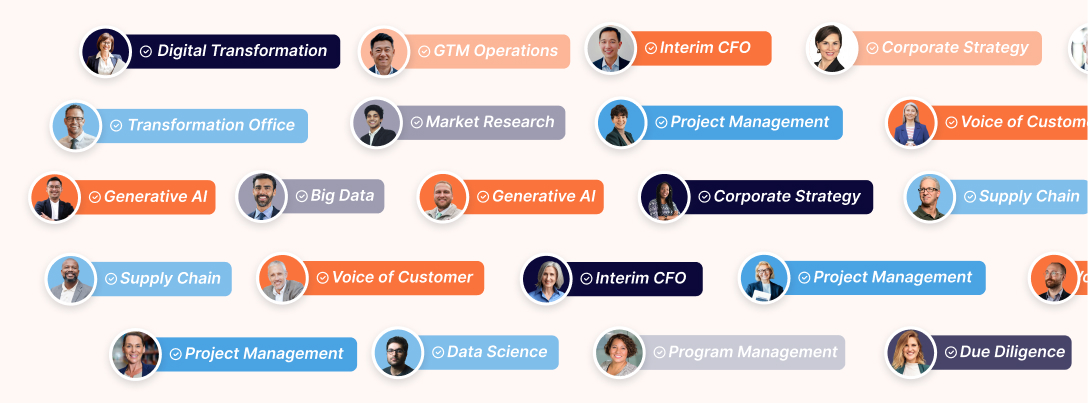A Guide to “Consulting 2.0” for Consulting Firms

Today’s consulting firms need the increased operational agility that Consulting 2.0 provides.
The consulting industry, once characterized by its stability and well-established business models, is changing dramatically. Multiple disruptions are reshaping it, including macroeconomic forces, technological advancements, and new workforce models.
1. The global economy and regulatory environment create unprecedented challenges to capacity balancing. It’s more difficult today to plan and balance the client work to be done with the consulting hours available to deliver. The commitment to the fixed costs and overhead around recruiting, hiring, onboarding, training, developing, and compensating FTEs in a volatile environment is risky.
2. Top talent wants more flexibility in how, when, where, and for whom they work. Many experienced in-house consultants are leaving the big consulting firms and going independent in order to gain more control over their work. At least a dozen former Partners from top-tier consulting firms join Catalant every month.
3. Clients don’t want to “train” your junior consultants on their dime. At a time when clients demand to see results faster than ever, they want experienced consultants–i.e., those with operating experience and business know-how–to come in and add value immediately.
4. AI is changing the game for consulting, impacting operations, delivery, and client services. AI is reducing headcounts, while also impacting client expectations for what actually gets delivered, and how.
Given these disruptions, adopting a more flexible approach to operating and delivering on clients’ needs enables you to evolve and remain competitive.
What is Consulting 2.0?
Consulting 2.0 is a modern, digitally-enabled approach to solving complex business problems, giving leaders (even those outside of the C-suite) access to the expertise of business professionals who have solved their problems before.
Consulting 2.0 provides access to the in-demand expertise you need, whenever you need it, and for as long as you need it. Your consulting firm benefits in multiple ways.

Why You Need to Transition to Consulting 2.0
By understanding the forces driving this change and implementing strategic adaptations, consulting firms can thrive in this new paradigm. Here are just a few reasons you should transition to Consulting 2.0:
1. The accelerating pace of change in multiple business areas, including:
- Economic volatility and a fast-changing regulatory climate: Fluctuating business cycles require more flexible resource allocation.
- The end of information asymmetry: Today, much of the information and frameworks that were once proprietary to consulting firms are now accessible through online resources, business publications, or other institutions.
- Client expectations: Clients aren’t as interested in bringing in consulting teams of generalists and/or juniors; they increasingly seek specialized expertise. Often, this is a preference for experienced consultants who are also operators.
- Technological enablement: On-demand talent platforms like Catalant make accessing and leveraging external talent easy.
2. Client planning cycles and projects have shrunk:
- There is increased scrutiny on big-ticket, long-term, and expensive consulting commitments/projects.
- Today’s clients want shorter cycles of change, ones marked by the rapid deployment of customized and iterative solutions.
- Many clients are shifting from long-term retainers to discrete, outcome-focused projects.
3. Access to talent pools is shifting:
- Case teams composed of purely FTE consultants are giving way to blended approaches that combine core internal teams supplemented by external specialists and a networked talent strategy.
- Lots of top talent have left big consulting firms in order to gain independence, achieve work/life balance, and go deeper into subject areas. More talent is available on demand than ever.
- Platforms like Catalant pre-vet talent and help you build a virtual talent bench that best suits your evolving practice needs and strategic outlook.
How Consulting 2.0 Transforms Your Operations
Forward-thinking consulting firms are incorporating Consulting 2.0 into their business models, resulting in:
1. The ability to flex into different practice areas and geographies, depending on market conditions, client needs, and your firm’s strategic initiatives.
2. The ability to better manage costs and workload fluctuations without having to add permanent headcount.
3. The ability to accommodate projects of varying sizes and complexity, freeing firms of the rigidity that can negatively impact client service and satisfaction.
4. Access to long-tail, niche expertise when it’s needed without incurring the fixed cost of an FTE.
How Catalant Can Help
By strategically integrating platforms like Catalant, traditional consulting firms can create hybrid models that combine the best aspects of established firms, such as strong client relationships, institutional knowledge, and quality assurance, with the flexibility, specialization, and efficiency of Consulting 2.0, unlocking the ability to meet clients where they are.
With Catalant, you gain access to thousands of highly-skilled independent consultants — many of whom have experience at Fortune 500 companies, global consulting firms, and leading private equity firms.
Interested in bringing Consulting 2.0 to your firm?
Let’s Talk











